by Michael Cropper | Jan 27, 2014 | Digital Marketing, Events |
We recently attended a digital marketing conference in Manchester called SAScon where we heard some exciting statistics from some leading UK brands including ASDA and MoneySupermarket.com. So we thought we would share some of the insights from the event so you can see how this can apply to your business.

Session 1 – The State of the Digital PR Nation
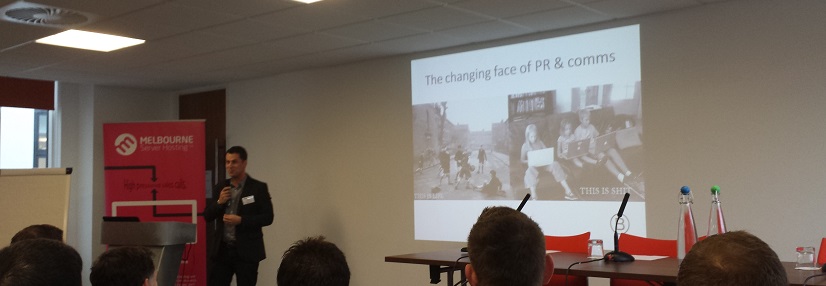
The first session of the day kicked off with a discussion around the state of the digital PR world with Drew Benvie, the Managing Director of a London based communications agency who talked through his experiences. The key message from the session was that social media has disrupted the PR industry with brands being able to connect with their audience easier and faster than ever before. So much so that the San Francisco Chronicle are putting all of their journalists through a two month social media boot camp.
Drew highlighted how businesses are increasingly moving away from the traditional social media manager and towards a more social business as we have illustrated below;
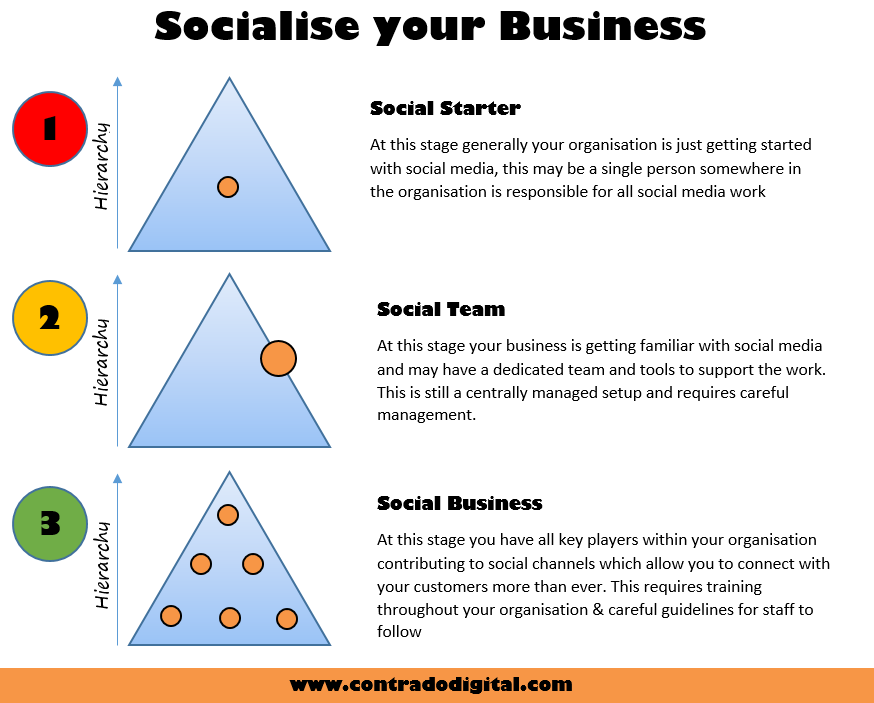
Socialise your Business
This involves everyone throughout an organisation to be utilising social media, from marketing teams, customer service teams, human resources teams, sales staff and C-level people. Businesses need to move from simply being digitally adapt, but also being socially adapt and with people checking their phones an average of 110 times per day this is a huge opportunity to get in front of your audience.
Turning traditional PR on its head was further highlighted with statistics that 90% of media is consumed on a screen of some sort which is a phenomenal amount.
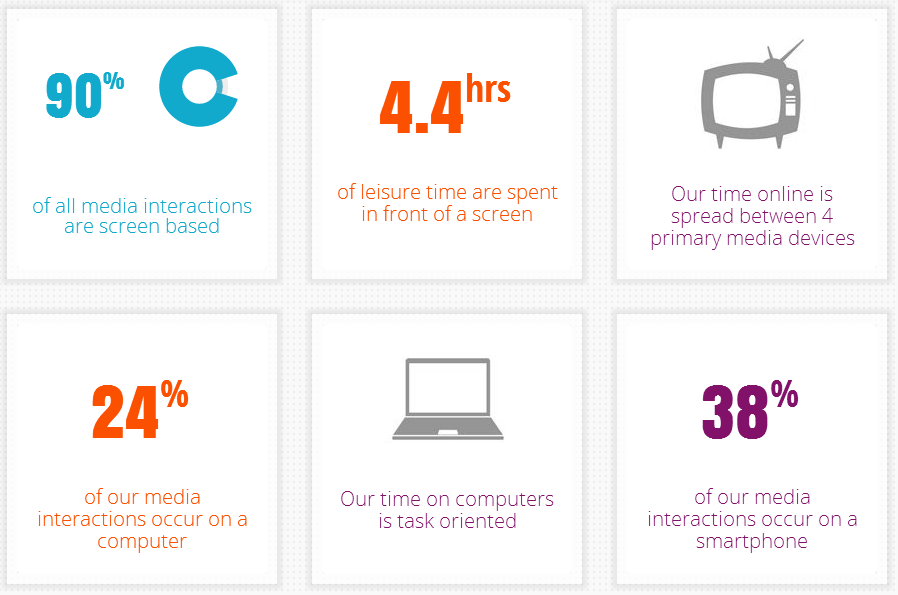
90% of all Media Interactions are Screen Based
The future was clearly looking towards a world of image sharing, wearable technology such as FitBit, messaging and data. With large brands looking beyond followers, fans, engagement & CTR and instead are using social media to drive footfall into their stores since the offline and online worlds are intrinsically linked. Brands are struggling to keep up with the warp speed changes within the industry though.
Session 2 – Where Next for Metrics

The next session was a panel to discuss where we are heading next for metrics and measuring success in the digital world. Some of the interesting points raised throughout the session was that while Universal Analytics has been available for a while now, it hasn’t really been picked up by many to utilise the full features available. It will be interesting as this gains more traction to see how brands begin to join data together in exciting ways. One example given was how one brand utilised custom dimensions within Universal Analytics to include weather conditions and geo-location to understand what impact website visitor numbers and revenue figures were impacted by these. One of the key features with Universal Analytics is the amazing ability to understand customers, not just visits. This is something to cover in a future post, but in summary Universal Analytics allows you to see when a customer visits from multiple devices which can provide some really cool data;
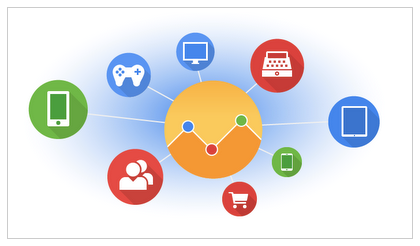
Universal Analytics
With data being so easy to capture, it is essential to capture as much data as possible to understand your customers better. Once the data has been captured, it can be analysed for a deeper understanding of trends and insights. On the topic of data, businesses are moving away from last click attribution models to track results, but looking at a more holistic approach and including data from first click attribution models. This helps to provide a true insight into how your business is performing which allows you to make smarter decisions about where to invest in the future.
Leading on from this additional data and understanding allows you to tailor content towards your audience. A prime example of this is for customers accessing your website from an iPhone while browsing for new laptops. It is extremely unlikely that those visitors are going to be interested in budget end PCs, instead show those customers products they are most likely interested in such as Apple laptops. Not only will this improve the customer experience, but this will also lead to an increase in conversions and sales.
On the content side, it was stressed about not simply creating content to generate links, but to fully understand where this content fits into the customer buying cycle. Only then will this content truly add value and deliver long term results. Content should be adding PR value, gaining mentions on other websites, being shared on social channels and the on-page data metrics should indicate how much customers enjoyed viewing the content.
With the recent change in (not provided), several companies in the digital space have attempted data modelling to retrieve this data by looking at Click Through Rate data on the search engine results pages along with keyword rankings. Although this hasn’t produced any models that are accurate enough to rely on. Following on from this, it was emphasised that a #1 ranking for a specific keyword isn’t the metric that businesses should be focusing on. In situations where a strong brand is ranking in position two or three, then this will still generate more clicks as customers prefer to view content from them than others. Metrics that businesses need to focus on in 2014 need to be focused around the right metrics for their business that are going to give a deep understanding of customers and not simply vanity metrics. Ultimately, revenue is the end point for most businesses to focus on, so other metrics need to work towards supporting this main KPI.
Session 3 – Why Content and Context are the Key to Making Meaningful Social Connections

The third session of the day was from Dominic Burch, Head of Social at ASDA who gave a fast paced talk with insights into how ASDA utilise social media. Firstly what might surprise you is that an organisation the size of ASDA only has two people within their social media team, yet they manage hugely successful platforms that connect with their audience.
Dom started out with five simple thoughts;
1) The old rules don’t apply anymore
2) ASDA are a media owner and they’ll increasingly act like one
3) ASDA are a connector, not a collector
4) ASDA will only succeed if they win the trust of shoppers
5) Listen first, engage second, influence third
One clear theme throughout the day is that brands are increasingly stepping up to connect more with their audience and customers. To do this you need a good understanding of your customers, and it is clear that ASDA do know who their customers are. The image below clearly shows that ASDA know who their customers are and where they are online;
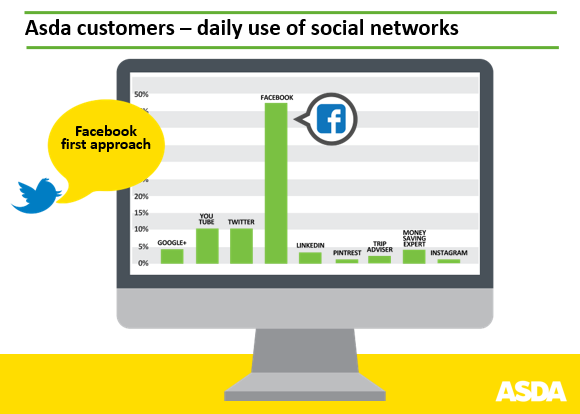
ASDA Customers on Social Media Channels
For ASDA, with Facebook being by far the most popular channel, this helps them to direct the strategy towards targeting those customers. Following on from this, ASDA also know that the typical Facebook follower has 232 friends and follow a total of 92 brands on Facebook, so ASDA need to keep their attention and stand out from the crowd.
One clear benefit of social media for ASDA is the ability to reach a huge audience and influence those people. On a monthly basis, ASDA’s Facebook page reaches 8.7 million people, generates 279,000 interactions and earns 157,000 clicks back through to their website. These are enormous numbers when remembering this is the work of only two people at ASDA. When comparing this to their traditional PR approach, where they were spending £150,000 per press release in a national newspaper (and they were running three of these per week!), it is clear that social media is a far greater opportunity to connect with their audience in a meaningful way. With the reach from social media, this tips the balance of power and enables ASDA to control their messages to their audience instead of going through traditional national newspapers.
While the above figures showcase the reach ASDA’s Facebook page has, Dom did stress that it is important not just to chase the numbers. Having a large following is utterly pointless if those people aren’t your target audience, a smaller number of more engaged followers are far more beneficial so connect to the right people with your messages.
In a similar theme, social media was compared with traditional TV advertising. ASDA has an 18% market share in the UK, meaning that running an advert on Coronation Street means that you are advertising to people who simply aren’t interested in the brand and wasting budget on this. Comparing this with social media, this allows a really targeted approach towards your audience to make your budget more effective at connecting with your audience.
Interestingly enough ASDA don’t have a huge budget for social media, so they have to focus on using relevant and low budget content that they can share socially. An example was given that with a £100 investment (yes, that low from a brand the size of ASDA!) resulted in content being shown in 100,000 newsfeeds of their audience. When comparing this to traditional PR, this is quite a difference. Another example of this was when a customer posted a question wondering if their dad was one of their oldest home shoppers. ASDA then went to visit the gentleman, took a photo and asked their Facebook fans to wish him a happy birthday which resulted in 25,000 likes for such a simply and cheap PR opportunity.
It was reiterated about the well-known fact that the best way to increase engagement on social media is to ask a question. This is clear when you compare ASDA’s engagement levels with their competitors;
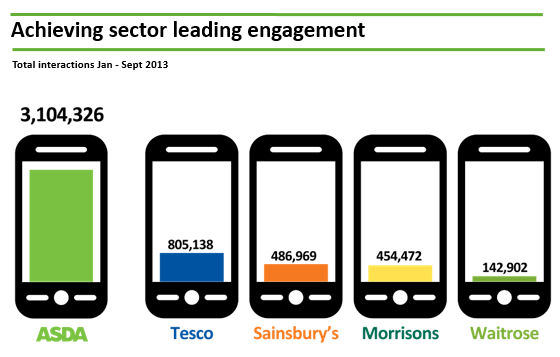
ASDA Social Media Engagement Levels
In-fact, ALDI do actually beat ASDA in terms of engagement levels, but this is a clear indication that ASDA are leading the way. One point made was that customers love it when ‘Del Boy Offers’ appear with the likes of 50p for 1 or 2 for £1. When customer see offers like this, straight away they are posted on social media channels which adds an extra dimension to the social media channels since it is essential these type of things don’t happen too often as it doesn’t show ASDA in a good light. Following on from this, in more extreme examples when there is a potential PR issue on social media, it is essential to take this offline to avoid it turning into a PR disaster. Never try and solve issues in a public space.
On the topic of follower growth, it was outlined that they have found promoting content and posts to friends of friends to be an effective method. The thought being that people who shop at ASDA are likely to be friends with other people who shop at ASDA. This can be seen in the graph below which contains the number of mentions over the past two years for ASDA;
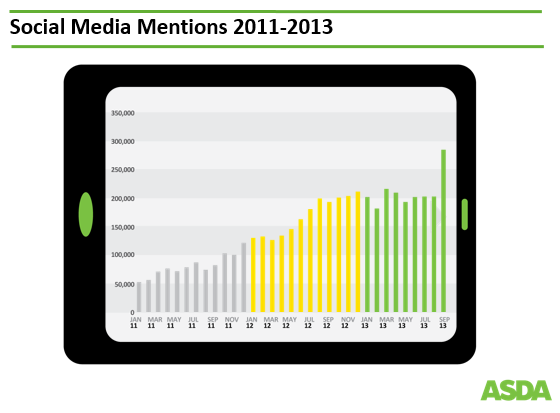
ASDA Social Media Mentions
Following on from this, ASDA had 268 million organic page impressions on their Facebook page. They were expecting to reach around the 300 million mark, although the Facebook update which tweaked their algorithm deciding what content to display in users newsfeeds really impacted ASDA’s organic visibility.
Taking a look in-store, some interesting statistics included that ASDA FM has a staggering 18 million listeners per week. Then looking at online and offline, the ASDA shop website gets 6 million visits per week, where 1 million of these use the store locator to find one of the 560 shops that are in the UK. Traditionally businesses have looked at online and offline as completely separate, although ASDA realise that people who shop online also shop in-store. So it is important to remember this when sending someone an email that they haven’t shopped online in a while, as they have likely been visiting in-store instead. They aren’t two completely separate groups of customers.
ASDA have started to link social media back to their website with their #ChosenByMe range which brings in social mentions together into a single place. A few other interesting ways ASDA is using social media can be seen on their editorial calendar below;
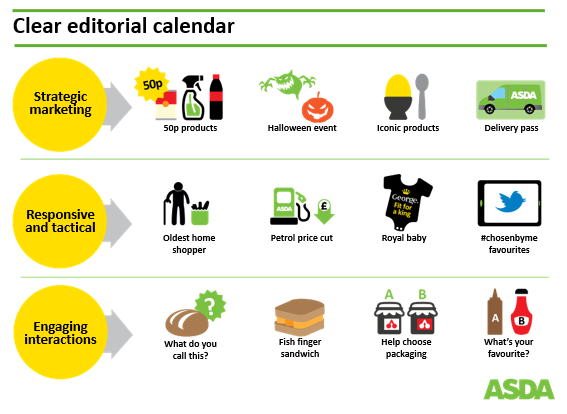
ASDA Social Media Editorial Calendar
From asking customers to help choose packaging on products, which resulted in 25,000 customers giving feedback within 1 hour, which is a huge opportunity for market research. To the good old debate about what sauce is best on a bacon butty, and ASDA found that it is quite evenly split. One key message was that content needs to start at the strategic level of your organisation. What key messages do you want to be talking about and who do you want to be talking to. Knowing this will help guide your social media activity.
Some final thoughts came around how we are going to be seeing much more of a ‘pay to play’ model on social media with changes in their algorithms leading to decreased visibility for brands. Long term we are going to see the death of the social media manager as we move towards social organisations at every level. Customers expect instant responses on social media channels and we are starting to see a much stronger interplay between social media and TV which was a similar theme mentioned at a recent event we attended, #SocialMediaWhatsTrending
Session 4 – Joining the Dots between PR, Social & Search
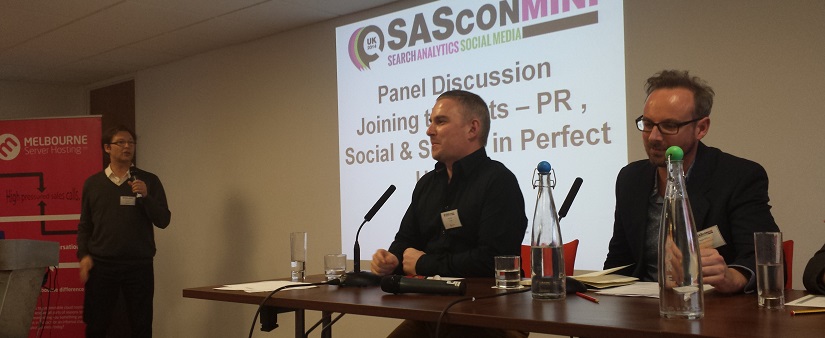
The next session was a panel discussion around the importance of joining the dots with digital marketing instead of treating each channel separately. The key message from the session was about how departments need to work together to achieve success. PR people need to be talking to SEO people, and vice versa. People working purely in SEO need to look towards telling stories to their audience. Then a common theme was around how everyone needs to be responsible for reputation management online. It is extremely easy for things to turn bad online, so everyone needs to be thinking about this with everything they are doing.
Session 5 – The top 5 Brands that ‘Get It and Deliver It’
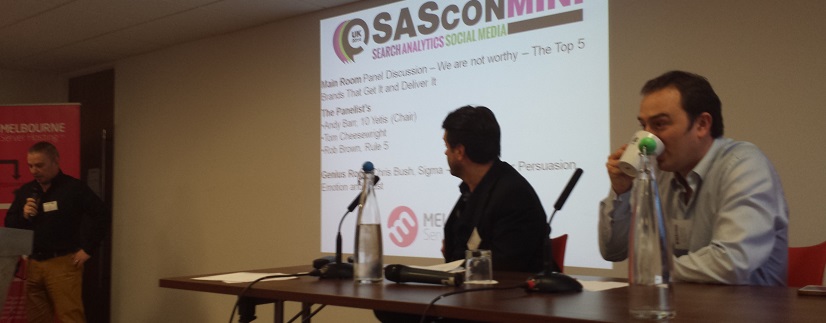
The fifth session of the day was another panel discussion that was focusing on brands that clearly understand the value of digital marketing.
Burberry
Interesting statistics including that 30% of all traffic to their website came from Facebook in 2013, with official sources stating that Facebook is a larger traffic source than Google for Burberry. This may not come as any surprise when you realise that 60% of Burberry’s marketing budget goes towards social media.
One of the most exciting thing about Burberry is how they have bridged the gap between digital and the real world within their Regent Street, London flagship store. If you haven’t seen this before, then just watch the video below and be mesmerised;
Red Bull
It is difficult to tell if Red Bull is a drinks company or a content marketing company now with what they produce. Just a few examples of how Red Bull have revolutionised content marketing by creating impactful and unusual content for their audience.
Then we have the Felix Baumgartner jumping from the stratosphere which was only available to watch on YouTube and the shortened version has had a staggering 35 million views;
British Cycling
Another example given was with British Cycling whereby at an event, they understood that social media was key to the event. So far as they had a social media hashtag on the cycling track and a van outside the venue with skills video editors in so they could take the footage, quickly edit and publish to social media channels. This resulted in content being available on YouTube after crashes within as little as 10 minutes from the event happening.
We are going to see much more of this event based marketing especially with the use of collaborative web tools which allow you to easily share content and data with your colleagues around the world within minutes.
Small Town Somewhere
A strange and slightly odd one was how one small town somewhere (Sorry, I can’t remember the name of it, but never the less, it highlights the point), actively used social media to publicise the town. What they did was to print & post a photo of everyone who liked their Facebook page onto a physical notice board within the town. Within a matter of hours, they had already filled up the board and continued to receive further mentions online.
NSA & GCHQ
The final one was rather tongue in cheek, with the NSA and GCHQ knowing everything about everyone. Who said government departments don’t ‘get’ social media.
Some other interesting points that came from the discussion was that everything works on an evidence based approach with digital unlike traditional marketing methods which can be notoriously difficult to measure accurately. It is important to use digital platforms to streamline communication and process, and if necessary completely remodel your business around what is possible. You have to ask yourself, is your organisation structured in a way that will help you succeed? You only have to look at the likes of HMV and Waterstones to see what can happen if you are too slow to adapt to changes in the market. This is specifically true of traditional media businesses, as they are needing to completely re-think their business to compete digitally.
One prime example given was how British Airways only monitor their social channels between 9-5 UK time, yet their customers are active around the clock as they travel to/from their destinations. This is a prime example of how businesses can adapt to the changing needs of customers to provide a superior service. Co-op have been an early adopter of Snapchat for marketing activities by running a campaign targeting students.
The key message throughout the session was that businesses need to get over the fear of failure, make changes fast and fail quickly. Some businesses are doing to need to fundamentally evolve throughout the organisation to keep ahead.
Session 6 – How to Break the Cycle of Bad Marketing
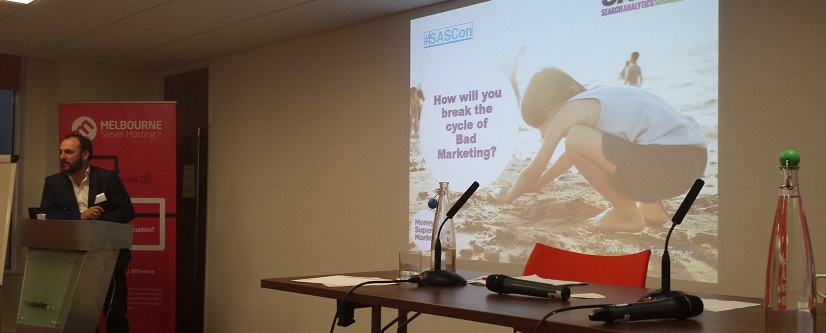
The final session of the day was from Phil MacKechnie, Head of Organic Performance at MoneySupremarket.com. Starting off with some exciting statistics, the three websites within the group TravelSupermarket.com, MoneySavingExpert.com and MoneySupermarket.com generate a huge 8 million visits per week.
Starting again with a key theme from throughout the day, the message was clear that businesses need to stop ignoring their customers and start to engage with them. Listen to them, help and support their needs with all marketing activities. There is no need to go chasing new big and shiny things, instead get back to the basics and start with your product, place, sales service and promotion. All of which need to be 100% focused on your customers.
Content is key for them as they communicate with their customers, so businesses need to get some good ideas and work together with key stake holders throughout the organisation. Working in silos has to stop and collaborative working is the only way to succeed long term. Purely from an efficiencies point, working together means more effective marketing spend and data can be shared between teams easily. Don’t get stuck in a content rut, understand what is working and what isn’t then adapt as necessary. This may result in having to look at team structures to understand how teams can work more effectively together.
A phenomenal 50% of all traffic is from mobile and tablet devices on TravelSupermarket.com, which really does highlight that a responsive website needs to be the number 1 priority in 2014. Customers are accessing your brand, content and website throughout the day on multiple devices, so your business needs to seriously consider what this means and what needs to be done to improve all these areas.
On the Search Engine Optimisation front, one only has to look at the messages Google is putting out about what not to do. These are clear indicators about what Google doesn’t like. Instead, start to look at campaigns and events as this will help with your Search Engine Optimisation efforts as well as building your brand. One message following on from this was that businesses that don’t have a strong brand online are going to find it ever more difficult to compete as customers look towards recognisable brands when purchasing online.
Finally the focus turned to KPIs within your business and the importance of getting these aligned. If different departments have competing KPIs then this simply isn’t going to work. Instead, work to align your business so all departments are working towards a clear strategy to target your customers.
Summary
Overall the SAScon event was extremely insightful as I’m sure you can see from the masses of information above. Hopefully this will give your business some food for thought about what you need to be working on in 2014 to succeed. Some of the key messages throughout is that you need to ensure your entire organisations is working towards a clear strategy to target your customers and forget about working in silos. There are some exciting examples above about how you can increase your organic reach across all channels.
by Michael Cropper | Jan 21, 2014 | SEO |
Digital marketing and the digital industry is moving at a faster pace today than ever before. Businesses we have spoken with keep telling us that their main issue is just keeping abreast of the changes, let along figuring out how to make the changes work for their business, that’s where we come in to help though. In 2014, the speed of change is only going to increase and from looking at the statistics, it is clear that digital marketing, social media and data are the key skills marketers are finding challenging.
Below we will take a look through some of the key changes that are happening in the digital world and what this means for your business in 2014. We would love to hear your thoughts too, so leave a comment below.
Cloud Technology
I’m sure you’re familiar with ‘The Cloud’ all of the benefits this is bringing to the world, we have seen a greater increase towards cloud based technologies in business for a number of reasons. This is not simply for traditional file sharing though, this is for your traditional software packages and for team collaboration too.
Take a look at the Microsoft Office 365 product, and if you aren’t using this already then think about your standard Office suite that has been on an episode of ‘Pimp my Ride’. This may seem like a strange item to look at initially as you may be wondering what this has to do with digital marketing. Quite simply, the flexibility these types of product have along with the likes of Dropbox and project management tools allows your business to collaborate on projects in a much more efficient way than ever before.
We are seeing trends with companies utilising staff around the globe to offer support for their customers around the clock, with cloud based technologies powering this transition. Within the younger generation particularly, and I do include myself within this bracket (no sniggering!), more companies are utilising cloud technology to give staff the flexibility to work remotely while still being able to complete their job. Think of cloud printing, cloud based project management tools and cloud based file systems. The default 9 – 5 is eroding fast, with the work and home life blending together and people simply logging on to work on projects at times that are suitable for them.
Integrated Online Marketing & Breaking down Silos
This has to be the biggest change we are going to see in 2014, an integrated approach to digital marketing will be key. We have started to see this last year with a few innovative companies, although a lot of companies are still working in silos when it comes to digital marketing. To succeed long term, quite simply, an integrated approach is essential.
Let’s first look at your customers, these are the people who are going to be interacting with your business on multiple occasions throughout their purchasing journey. I do say ‘purchasing journey’ instead of ‘purchasing funnel’ as a funnel is too much of a narrow focus to be looking at in 2014. Customers don’t simply visit your website once, then purchase a product. The customer purchasing journey is far more complex as can be seen by this research by Google. Looking at the data, around 50% of customers purchase after their initial visit.

Understanding the Customer Purchase Journey
What this means is that 50% of your customers are going to be interacting with your business at another point on their journey prior to making a purchase. This is significant as those other interactions could be from search engine optimisation, pay per click advertising, email campaigns, display advertising, social media and from various devices such as a desktop computer, mobile phone or tablet. You have to ask yourself, when a customer interacts with you are they getting a positive or negative impression of your business, products or services? All of this is going to impact how many potential customers turn into real paying customers.
Breaking down the silos
An integrated approach from all areas within your business is essential for long term success, although one of the key issues that businesses face is different teams and departments working in silos and often towards competing KPIs. It is important to recognise when this is happening and take the necessary steps as a business owner to make the changes needed to allow a more collaborative approach throughout your organisation. Below are just a few examples of areas we have seen that needed improving in the past.
Targeted emails
Do you ever receive untargeted emails from companies you have purchased from in the past? If you have purchased a luxury Barbados holiday from a company in the last, then next week they are sending you offers about a holiday in Blackpool then this only reinforces to the customer that you don’t know what you are doing. The technology exists to allow you to link systems together and personalise your emails. Not only will this lead to a happier customer but this will also help increase revenue from email campaigns.
Multi-Channel Messages
As a business you will be working towards key goals both financially and strategically. Part of this process involves getting the right messages in front of the right audience for your business to fuel growth. If teams are working in silos then it often happens that one team is sending messages out in one area while another is sending out a different message elsewhere. A prime example of this last year was when Horsegate hit the headlines, with Tesco being at the forefront of the media. While handled well, there was a clear lack of communication somewhere along the way which led to a tweet being published stating “It’s sleepy time now so we’re off to his the hay” which wasn’t the best of times to tweet this out.
The key focus for 2014 needs to be about getting the right messages out to your audience across all channels in a collaborative and integrated way.
Socialise your Business
2014 is the year where more business will begin to shift the focus away from ‘someone’ managing social media towards a fully social business where key members of staff are contributing. You can think of this as three stages of socialising your businesses which is a concept I came across at a recent conference I attended;

Socialise your Business
Expanding your social reach through the key assets within your business, your staff, allows you to connect with your audience and customers like never before. For most businesses they are at either the Social Starter or Social Team phase. Increasing your social reach as a business is going to be key to capturing the attention of your audience and engaging with them.
Pay to Play
An interesting theme that we are likely to see more of in 2014 is a pay-to-play model for social media. Facebook has openly admitted that businesses are likely to see a decrease in organic reach for business pages as their new algorithm rolls out. With Facebook pushing their advertising platform more, then this should come as no surprise, but what it does show is that businesses are going to need to adapt to this change.
Stop Thinking about Link Building
Within the Search Engine Optimisation area, there is always a focus towards building more links and is often a key focus for clients because this is what they have read is important. Businesses need to stop thinking about building links purely to increase their rankings on search engines. This is not a good long term approach, to the point whereby Google’s Head of Web Spam, Matt Cutts, recently wrote a blog post telling people to stop using guest blogging to generate links.
Instead what businesses need to be focusing on in 2014 is about real world partnerships with websites and other non-competing businesses whose audience is the same group of people you are targeting. This again comes back down to really understanding who your customers are and what makes them tick. If you know your audience is young hip women interested in travel, then maybe Pinterest is going to be a good focus for you. Only by understanding who your customers are will you be able to really target websites and communities to get involved with.
Responsive Web Design
If you don’t already have a responsive website, then quite simply you need to make this a number 1 priority for 2014. With around 28% of traffic coming from mobile and tablet devices you could be missing out on valuable sales by making it difficult for customers to purchase products on a mobile device. This again comes down to every experience and touch point having either a positive or negative impact on your brand.
Brands that understand how potential customers are going to consume content differently are already leading the way with this change. Make sure you are one of the brands that isn’t falling behind and disappointing your potential customers.
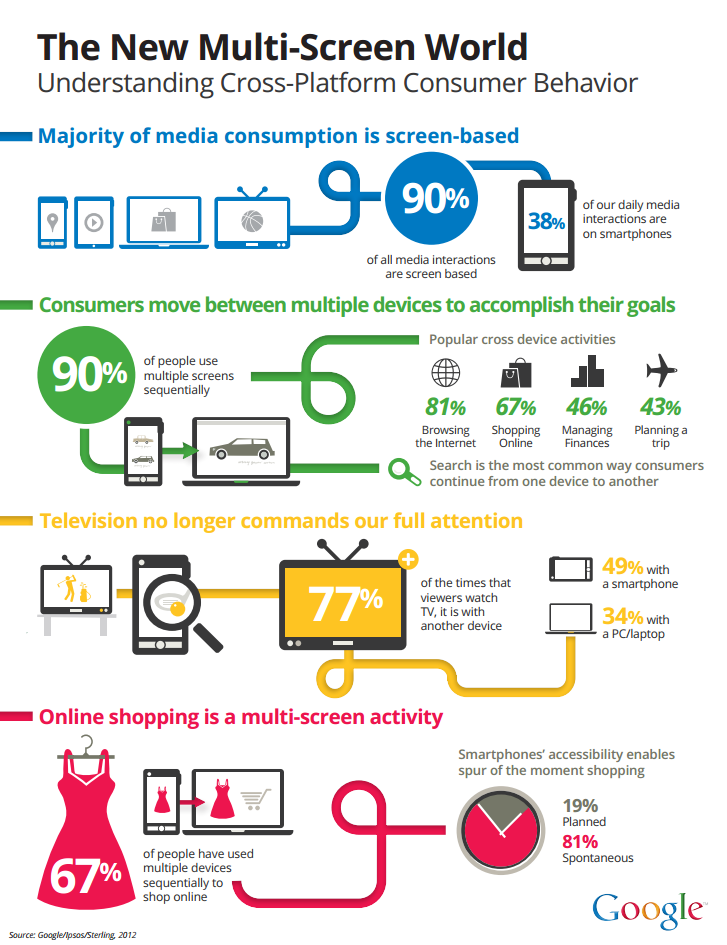
Understand Cross-Platform Consumer Behaviour
Source Google
Customer Focus
We have already mentioned the importance of focusing on the customer in 2014, and this is to really highlight the importance of this and how it can feed into your digital marketing strategy. Focusing on your customers allows you to understand exactly what they need and how you can help solve their problems. Simply ‘selling your products to anyone who is willing to buy’ approach isn’t going to cut it in 2014. Customers have more choice than ever to purchase from a competitor at the click of a few buttons, so show them you care and give them a reason to purchase with you.
Firstly, do you know who your customers actually are? Often with large ecommerce websites businesses may not be clear who their customers are as they simply see it is another ‘product’ that has been purchased by someone. If this is you then the first step is to clearly understand your audience, only then can you begin to create a marketing plan that is going to target those customers and key demographic groups.
Once you know who your customers are you can create relevant exciting and useful content for your audience. So instead of talking about your latest dresses in your catalogue, if most of your audience are men, then this may not be the best approach. The same applies for getting involved with your target audience on social channels and other online communities. If you don’t know who your audience is then how do you target them and engage with them?
As mentioned earlier, the tools are available to personalise content for your audience, send them targeted emails and get them involved with your brand and community. When you have a true customer focus you naturally move away from thinking about keywords and specific keyword rankings as part of your search engine optimisation efforts and more towards content themes which links in with Google’s recent Hummingbird algorithm update.
Is your Business Good Enough?
In a world where it is so easy for customers to let out their frustration online, this is an important point to take a look at your business and see where both products and services need to be improved. Simply looking to push more marketing budget towards a bad product or service is only going to lead to more issues to deal with from disgruntled customers.
The same applies if your business doesn’t add much value compared with competitors. If everyone is selling the same items purchased from the same suppliers then where is the value added? To succeed online you need to be adding real value for your customers, above and beyond simply selling products. Particularly in the product industry, Amazon sells everything you can imagine, and they do it well. What they aren’t good at is providing useful and insightful information for users and this is where smaller brands can jump in and connect with their audience more.
Technology & Connectivity
One key trend that is only going to grow in 2014 is in the area of technology and connectivity. A key phrase that is cropping up at the minute is the ‘Internet of Things’ which is a geeky way of saying that every electronic device will be connected to the internet. This is exciting for digital marketing because this gives us a lot more data and technology to experiment with to enhance the customer journey.
Look at some of the latest wearable technology including the Samsung Galaxy Gear, Google Glass and Google Contact Lens – all designed to allow people to interact with the digital world in a more sophisticated way. The Samsung Galaxy S4 has Near Field Communication built into the device which again increases the options available for marketers to utilise in campaigns. Watch this space in 2014 as new and innovative ideas are launched for large brands around the world.
We wouldn’t be talking about technology and connectivity without mentioning Google’s latest acquisition of Nest, a Smart Thermostat for your home. Not to go too futuristic, but have you seen the films Iron Man?

J.A.R.V.I.S.
Image source: Ron Mendell
Imagine how Nest could quite easily be upgraded with a microphone to allow you to say “OK Google: What time is it”, in a similar way you can already do on your smart phone. This really isn’t fantasy, but is something that brands need to start thinking about how people are going to be interacting with their brand differently in the years ahead through significant advances in technology and connected devices.
Another key focus following on from this is the rise of Smart TVs in the market place. If you aren’t aware already, a Smart TV is basically one that is powered through the internet, opposed to your traditional aerial. This is an exciting change as we mentioned about responsive design earlier, well what about responsive design for Smart TVs? 2014 is going to be an interesting time to see how customers use Smart TVs in comparison to desktop computers and mobile devices when browsing the web.
Data Driven Decisions
The amount of data that is available about your customers from different systems is huge, analysing this data allows your business to make informed decisions to help your business grow. 2013 was titled as the year where ‘big data’ would become common use, although the reality was quite different.
As businesses begin to use more tools and continue to expand their digital presence, we are going to see more businesses using available data to gain valuable insights into their customers. We will start to move away from the traditional ‘last click attribution’ model and more towards looking at cost per acquisition figures, customer lifetime value figures and understanding the whole customer journey better.
Likewise we won’t see a high bounce rate as a bad thing, instead we will star to understand that actually the customer simply had to go to work, then picked up their journey again at their lunch hour, then went home later in the eventing to discuss with their partner before making a purchase. This type of data exists and can provide real value to businesses to market to customers at every step along the way.
Overall
Well that is quite a lot of things to look forward to in 2014 and these are just a few of our thoughts. What we can be certain of is how 2014 going to move faster than ever before and businesses are going to need to really step up a level when it comes to their digital marketing activities. In such an ever changing environment with competition only a couple of clicks away, it is essential to engage with your audience and connect with your customers more than ever before across all channels.
by Michael Cropper | Jan 21, 2014 | Digital Marketing |
Digital marketing and the digital industry is moving at a faster pace today than ever before. Businesses we have spoken with keep telling us that their main issue is just keeping abreast of the changes, let along figuring out how to make the changes work for their business, that’s where we come in to help though. In 2014, the speed of change is only going to increase and from looking at the statistics, it is clear that digital marketing, social media and data are the key skills marketers are finding challenging.
Below we will take a look through some of the key changes that are happening in the digital world and what this means for your business in 2014. We would love to hear your thoughts too, so leave a comment below.
Cloud Technology
I’m sure you’re familiar with ‘The Cloud’ all of the benefits this is bringing to the world, we have seen a greater increase towards cloud based technologies in business for a number of reasons. This is not simply for traditional file sharing though, this is for your traditional software packages and for team collaboration too.
Take a look at the Microsoft Office 365 product, and if you aren’t using this already then think about your standard Office suite that has been on an episode of ‘Pimp my Ride’. This may seem like a strange item to look at initially as you may be wondering what this has to do with digital marketing. Quite simply, the flexibility these types of product have along with the likes of Dropbox and project management tools allows your business to collaborate on projects in a much more efficient way than ever before.
We are seeing trends with companies utilising staff around the globe to offer support for their customers around the clock, with cloud based technologies powering this transition. Within the younger generation particularly, and I do include myself within this bracket (no sniggering!), more companies are utilising cloud technology to give staff the flexibility to work remotely while still being able to complete their job. Think of cloud printing, cloud based project management tools and cloud based file systems. The default 9 – 5 is eroding fast, with the work and home life blending together and people simply logging on to work on projects at times that are suitable for them.
Integrated Online Marketing & Breaking down Silos
This has to be the biggest change we are going to see in 2014, an integrated approach to digital marketing will be key. We have started to see this last year with a few innovative companies, although a lot of companies are still working in silos when it comes to digital marketing. To succeed long term, quite simply, an integrated approach is essential.
Let’s first look at your customers, these are the people who are going to be interacting with your business on multiple occasions throughout their purchasing journey. I do say ‘purchasing journey’ instead of ‘purchasing funnel’ as a funnel is too much of a narrow focus to be looking at in 2014. Customers don’t simply visit your website once, then purchase a product. The customer purchasing journey is far more complex as can be seen by this research by Google. Looking at the data, around 50% of customers purchase after their initial visit.

Understanding the Customer Purchase Journey
What this means is that 50% of your customers are going to be interacting with your business at another point on their journey prior to making a purchase. This is significant as those other interactions could be from search engine optimisation, pay per click advertising, email campaigns, display advertising, social media and from various devices such as a desktop computer, mobile phone or tablet. You have to ask yourself, when a customer interacts with you are they getting a positive or negative impression of your business, products or services? All of this is going to impact how many potential customers turn into real paying customers.
Breaking down the silos
An integrated approach from all areas within your business is essential for long term success, although one of the key issues that businesses face is different teams and departments working in silos and often towards competing KPIs. It is important to recognise when this is happening and take the necessary steps as a business owner to make the changes needed to allow a more collaborative approach throughout your organisation. Below are just a few examples of areas we have seen that needed improving in the past.
Targeted emails
Do you ever receive untargeted emails from companies you have purchased from in the past? If you have purchased a luxury Barbados holiday from a company in the last, then next week they are sending you offers about a holiday in Blackpool then this only reinforces to the customer that you don’t know what you are doing. The technology exists to allow you to link systems together and personalise your emails. Not only will this lead to a happier customer but this will also help increase revenue from email campaigns.
Multi-Channel Messages
As a business you will be working towards key goals both financially and strategically. Part of this process involves getting the right messages in front of the right audience for your business to fuel growth. If teams are working in silos then it often happens that one team is sending messages out in one area while another is sending out a different message elsewhere. A prime example of this last year was when Horsegate hit the headlines, with Tesco being at the forefront of the media. While handled well, there was a clear lack of communication somewhere along the way which led to a tweet being published stating “It’s sleepy time now so we’re off to his the hay” which wasn’t the best of times to tweet this out.
The key focus for 2014 needs to be about getting the right messages out to your audience across all channels in a collaborative and integrated way.
Socialise your Business
2014 is the year where more business will begin to shift the focus away from ‘someone’ managing social media towards a fully social business where key members of staff are contributing. You can think of this as three stages of socialising your businesses which is a concept I came across at a recent conference I attended;

Socialise your Business
Expanding your social reach through the key assets within your business, your staff, allows you to connect with your audience and customers like never before. For most businesses they are at either the Social Starter or Social Team phase. Increasing your social reach as a business is going to be key to capturing the attention of your audience and engaging with them.
Pay to Play
An interesting theme that we are likely to see more of in 2014 is a pay-to-play model for social media. Facebook has openly admitted that businesses are likely to see a decrease in organic reach for business pages as their new algorithm rolls out. With Facebook pushing their advertising platform more, then this should come as no surprise, but what it does show is that businesses are going to need to adapt to this change.
Stop Thinking about Link Building
Within the Search Engine Optimisation area, there is always a focus towards building more links and is often a key focus for clients because this is what they have read is important. Businesses need to stop thinking about building links purely to increase their rankings on search engines. This is not a good long term approach, to the point whereby Google’s Head of Web Spam, Matt Cutts, recently wrote a blog post telling people to stop using guest blogging to generate links.
Instead what businesses need to be focusing on in 2014 is about real world partnerships with websites and other non-competing businesses whose audience is the same group of people you are targeting. This again comes back down to really understanding who your customers are and what makes them tick. If you know your audience is young hip women interested in travel, then maybe Pinterest is going to be a good focus for you. Only by understanding who your customers are will you be able to really target websites and communities to get involved with.
Responsive Web Design
If you don’t already have a responsive website, then quite simply you need to make this a number 1 priority for 2014. With around 28% of traffic coming from mobile and tablet devices you could be missing out on valuable sales by making it difficult for customers to purchase products on a mobile device. This again comes down to every experience and touch point having either a positive or negative impact on your brand.
Brands that understand how potential customers are going to consume content differently are already leading the way with this change. Make sure you are one of the brands that isn’t falling behind and disappointing your potential customers.

Understand Cross-Platform Consumer Behaviour
Source Google
Customer Focus
We have already mentioned the importance of focusing on the customer in 2014, and this is to really highlight the importance of this and how it can feed into your digital marketing strategy. Focusing on your customers allows you to understand exactly what they need and how you can help solve their problems. Simply ‘selling your products to anyone who is willing to buy’ approach isn’t going to cut it in 2014. Customers have more choice than ever to purchase from a competitor at the click of a few buttons, so show them you care and give them a reason to purchase with you.
Firstly, do you know who your customers actually are? Often with large ecommerce websites businesses may not be clear who their customers are as they simply see it is another ‘product’ that has been purchased by someone. If this is you then the first step is to clearly understand your audience, only then can you begin to create a marketing plan that is going to target those customers and key demographic groups.
Once you know who your customers are you can create relevant exciting and useful content for your audience. So instead of talking about your latest dresses in your catalogue, if most of your audience are men, then this may not be the best approach. The same applies for getting involved with your target audience on social channels and other online communities. If you don’t know who your audience is then how do you target them and engage with them?
As mentioned earlier, the tools are available to personalise content for your audience, send them targeted emails and get them involved with your brand and community. When you have a true customer focus you naturally move away from thinking about keywords and specific keyword rankings as part of your search engine optimisation efforts and more towards content themes which links in with Google’s recent Hummingbird algorithm update.
Is your Business Good Enough?
In a world where it is so easy for customers to let out their frustration online, this is an important point to take a look at your business and see where both products and services need to be improved. Simply looking to push more marketing budget towards a bad product or service is only going to lead to more issues to deal with from disgruntled customers.
The same applies if your business doesn’t add much value compared with competitors. If everyone is selling the same items purchased from the same suppliers then where is the value added? To succeed online you need to be adding real value for your customers, above and beyond simply selling products. Particularly in the product industry, Amazon sells everything you can imagine, and they do it well. What they aren’t good at is providing useful and insightful information for users and this is where smaller brands can jump in and connect with their audience more.
Technology & Connectivity
One key trend that is only going to grow in 2014 is in the area of technology and connectivity. A key phrase that is cropping up at the minute is the ‘Internet of Things’ which is a geeky way of saying that every electronic device will be connected to the internet. This is exciting for digital marketing because this gives us a lot more data and technology to experiment with to enhance the customer journey.
Look at some of the latest wearable technology including the Samsung Galaxy Gear, Google Glass and Google Contact Lens – all designed to allow people to interact with the digital world in a more sophisticated way. The Samsung Galaxy S4 has Near Field Communication built into the device which again increases the options available for marketers to utilise in campaigns. Watch this space in 2014 as new and innovative ideas are launched for large brands around the world.
We wouldn’t be talking about technology and connectivity without mentioning Google’s latest acquisition of Nest, a Smart Thermostat for your home. Not to go too futuristic, but have you seen the films Iron Man?

J.A.R.V.I.S.
Image source: Ron Mendell
Imagine how Nest could quite easily be upgraded with a microphone to allow you to say “OK Google: What time is it”, in a similar way you can already do on your smart phone. This really isn’t fantasy, but is something that brands need to start thinking about how people are going to be interacting with their brand differently in the years ahead through significant advances in technology and connected devices.
Another key focus following on from this is the rise of Smart TVs in the market place. If you aren’t aware already, a Smart TV is basically one that is powered through the internet, opposed to your traditional aerial. This is an exciting change as we mentioned about responsive design earlier, well what about responsive design for Smart TVs? 2014 is going to be an interesting time to see how customers use Smart TVs in comparison to desktop computers and mobile devices when browsing the web.
Data Driven Decisions
The amount of data that is available about your customers from different systems is huge, analysing this data allows your business to make informed decisions to help your business grow. 2013 was titled as the year where ‘big data’ would become common use, although the reality was quite different.
As businesses begin to use more tools and continue to expand their digital presence, we are going to see more businesses using available data to gain valuable insights into their customers. We will start to move away from the traditional ‘last click attribution’ model and more towards looking at cost per acquisition figures, customer lifetime value figures and understanding the whole customer journey better.
Likewise we won’t see a high bounce rate as a bad thing, instead we will star to understand that actually the customer simply had to go to work, then picked up their journey again at their lunch hour, then went home later in the eventing to discuss with their partner before making a purchase. This type of data exists and can provide real value to businesses to market to customers at every step along the way.
Overall
Well that is quite a lot of things to look forward to in 2014 and these are just a few of our thoughts. What we can be certain of is how 2014 going to move faster than ever before and businesses are going to need to really step up a level when it comes to their digital marketing activities. In such an ever changing environment with competition only a couple of clicks away, it is essential to engage with your audience and connect with your customers more than ever before across all channels.
by Michael Cropper | Nov 18, 2013 | SEO |
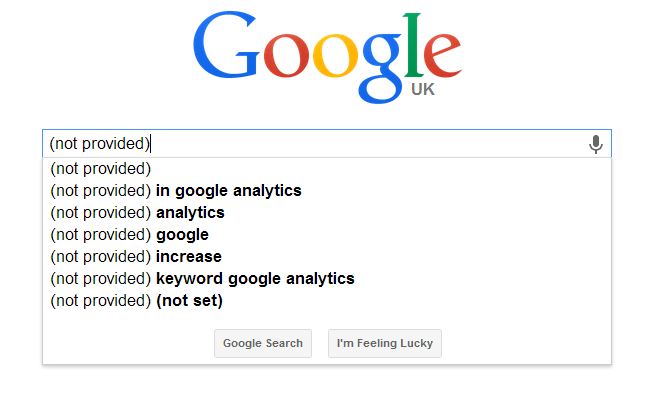
If you keep a keen eye on Google Analytics (and you should be doing) then you will have noticed a significant change taking place recently with the change in how organic keywords are being reported. Previously it was possible to see exactly what a user searched for on Google before they arrived at your website as can be seen below;

Google Analytics Keywords
Now you may notice that the majority of your keywords are being listed as (not provided) which isn’t that useful at first glance as it looks like all of the useful data has gone missing.
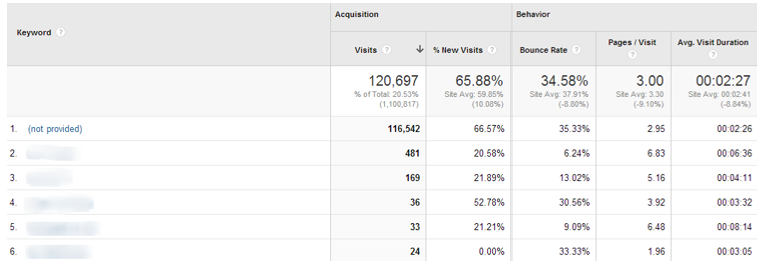
Google Analytics Not Provided Keywords
There is no way to retrieve this data now that the change has happened, so we’ll take a look through a few other ways of finding out similar data.
So what is (not provided)
Since October 2011 Google has been steadily rolling out secure search for users. Secure search is when people are searching on https://www.google.com opposed to http://www.google.com (notice the ‘S’ in the first bit of the URL, this stands for Secure).
The first step Google made to masking keyword data as (not provided) was when they automatically switched users to secure search when they were logged into a Google product (Gmail, Analytics, Chrome, YouTube, etc.). As more users continue to use Google products, more of your customers began to be included within the (not provided) bucket.
Over the past two years, this has continued to grow and has recently increased to almost 100% for many websites.

Google Analytics Rise in Not Provided Keywords
When did (not provided) suddenly jump
The percentage of (not provided) traffic from organic search has been steadily increasing since October 2011 when it was first introduced. More recently in early October 2013 the percentage hugely increased and is often now nearly 100% with many websites;
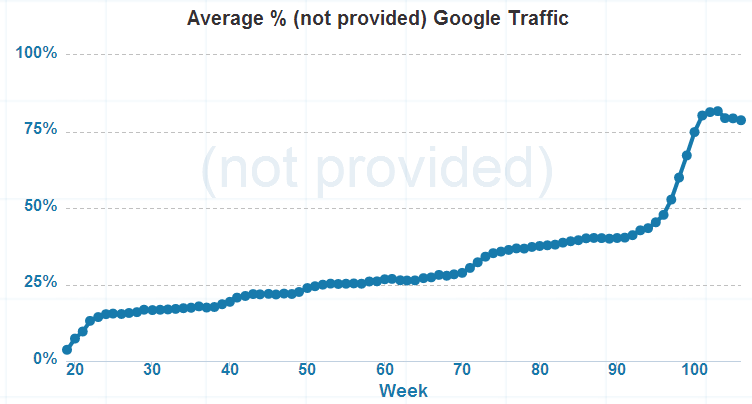
Overall Rise in Not Provided as Percentage
This change happened when Google made the switch to default users to secure search when searching on Google. This change to secure search for most people means that keyword data is now being reported as (not provided) within Google Analytics.
What we have lost
Previously reporting on Search Engine Optimisation work was straight forward, you could tell exactly how much traffic was coming to your website from specific keywords which you could then link back to any work that was completed to improve the keyword rankings and traffic for those keywords. This is what we have lost, the granularity. As the majority of keyword data is now being reported as (not provided) then this means that it is not possible to look at such a detailed level about what keywords people used to find your website. That being said, this isn’t necessarily a bad thing.
While this granular level of reporting has disappeared and isn’t ideal, this change is actually forcing companies to focus on the important metrics when it comes to optimising their website which is good. We have always focused on the important metrics for our clients which are traffic, conversion rates and revenue levels. The change in (not provided) keyword data is actually forcing businesses to look at these metrics too, instead of focusing on individual keywords and vanity ranking metrics.
Tracking the important metrics
As mentioned above, the important metrics to monitor for your website are traffic levels, conversion rates and revenue figures. When businesses are focused on these important metrics, the detailed specific data which has now been lost isn’t such a huge disadvantage. As long as traffic levels are increasing which is leading to increases in revenue then this can provide accurate reporting for Search Engine Optimisation efforts.
Focusing on Customers, not Search Engines
Real Search Engine Optimisation work is all about focusing on your customers & potential customers, providing them content that is useful and engaging. This work doesn’t rely on being able to see the individual keywords your customers are using to find your website, it comes from knowing everything about customer needs. As mentioned earlier, this change is good for this exact reason. Previously businesses have been far too focused on specific keyword rankings and traffic on specific keywords instead of focusing on what their customers actually want. This change is helping shift the focus back towards customers.
Tracking branded & non-branded traffic
Previously tracking branded and non-branded traffic was as straight forward as filtering organic traffic based on what people searched for. For example if someone searched for “Contrado Digital” then this is clearly a branded search so they already know about the brand. Anyone who searched for something more generic such as Search Engine Optimisation Blackburn, then this would suggest that they may not know about the Contrado Digital brand at present, so this is a good opportunity to drive new customers. This is no longer possible with the rise of (not provided), which leaves us with a change in how to understand website visitors.
Often branded search queries will land on the homepage of your website, meaning that we can now use this as a new way to classify branded and non-branded search queries. What I would suggest here is to check what this looks like for your individual website as it may be that branded visitors land on various pages throughout your website. Thankfully the data is still available within Google Analytics from prior to the change, so this is easy to break out and check how your customers behaved prior to the reporting change.
What we have found across a range of industries is that often the majority of branded search traffic does land on the homepage which makes it easier to monitor non-branded search traffic, since they land on other pages through the website.
With this change we would recommend reporting on organic traffic as follows;
- Branded organic traffic: Visitors landing on the homepage from search engines
- Non-branded organic traffic: Visitors landing elsewhere throughout the website from search engines
This new classification of branded and non-branded traffic can help to fully understand how things are performing over time.
Why has Google made this change
The official reason Google has given behind this change is due user privacy although this doesn’t quite stack up as the keyword level data is still available within Google AdWords. This suggests that Google is trying to push more businesses to use the AdWords platform to gather this additional data about what keywords users are searching for. We may never know the real reason behind this change, although it is going to be interesting how this develops over the next 12 months.
Who has this change impacted?
In summary, everyone. Everyone who uses Google Analytics and other web analytics packages has been impacted by the (not provided) change at the same time. Unfortunately there is nothing that anyone can do at present to retrieve this data so it is important that businesses adapt to this change to look at new ways of reporting on results.
Alternative data sources
While the data may have disappeared from Google Analytics, there is some data still present within Google Webmaster Tools. While this data is no-where near as accurate as Google Analytics, it can help provide a guide as to what keywords visitors are searching for before landing on your website.

Google Webmaster Tools Search Query Data
Google Webmaster Tools can certainly still provide content ideas and good estimates about what search queries customers searched for prior to seeing your website within the search engine results pages. It will be interesting to see how this reporting develops over time as Google may add in additional data here.
Understanding the whole user journey
Often businesses will simply look at the conversions and traffic levels from an individual website visit from different traffic sources. Honestly though, think back to when you booked your last holiday, did you – in a single session – go to a hotel booking website, find the exact hotel you wanted in the exact location and book there and then? No, I didn’t think so. The whole user journey takes time.
First you start of researching holiday destinations on various websites. Then you research holiday packages or different hotels available, again on different websites. You may then want to discuss the options with your partner or family another evening when you have the time. So you may then come back to the website again in a few days to actually purchase your holiday.
The way that Google Analytics tracks conversions and revenue levels by default is using ‘Last Click Attribution’ which in basic terms means that a user clicked through to your website, then purchased during that same visit. The example I have just outlined above though shows that this is often not how customer behave.
Introducing ‘Assisted Conversions’. Assisted Conversions within Google Analytics report on what you would imagine, they show which traffic sources (organic, paid, referral, direct) are contributing towards new revenue. Below shows the number of conversions who first arrived at the website through organic search and later converted on a subsequent visit;
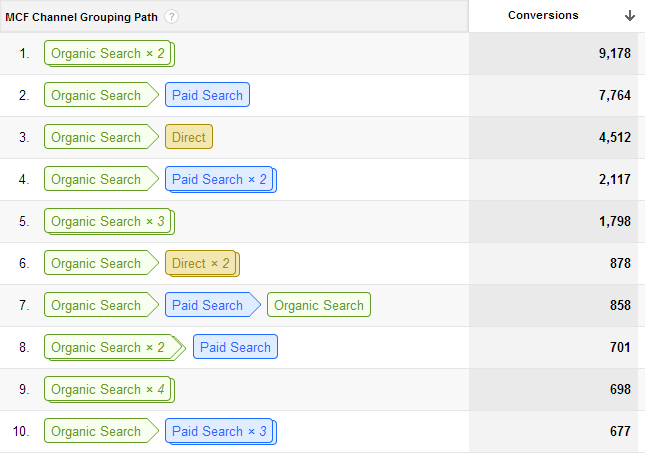
Google Analytics Assisted Conversions Data
As you can see in the image above, customers often visit the website multiple times prior to converting, and from multiple traffic sources. This again needs to be a key focus to accurately reporting on results from Search Engine Optimisation work.
The assisted conversions data is extremely powerful and can really help you to place a more accurate return on investment figure towards your marketing spend on different channels.
Summary
Hopefully this helps you understand all about (not provided) and how this change needs to be adapted to so you can report accurately on results for your business. If you have any other questions about (not provided) then leave a comment.
by Michael Cropper | Nov 18, 2013 | SEO |

If you keep a keen eye on Google Analytics (and you should be doing) then you will have noticed a significant change taking place recently with the change in how organic keywords are being reported. Previously it was possible to see exactly what a user searched for on Google before they arrived at your website as can be seen below;

Google Analytics Keywords
Now you may notice that the majority of your keywords are being listed as (not provided) which isn’t that useful at first glance as it looks like all of the useful data has gone missing.

Google Analytics Not Provided Keywords
There is no way to retrieve this data now that the change has happened, so we’ll take a look through a few other ways of finding out similar data.
So what is (not provided)
Since October 2011 Google has been steadily rolling out secure search for users. Secure search is when people are searching on https://www.google.com opposed to http://www.google.com (notice the ‘S’ in the first bit of the URL, this stands for Secure).
The first step Google made to masking keyword data as (not provided) was when they automatically switched users to secure search when they were logged into a Google product (Gmail, Analytics, Chrome, YouTube, etc.). As more users continue to use Google products, more of your customers began to be included within the (not provided) bucket.
Over the past two years, this has continued to grow and has recently increased to almost 100% for many websites.

Google Analytics Rise in Not Provided Keywords
When did (not provided) suddenly jump
The percentage of (not provided) traffic from organic search has been steadily increasing since October 2011 when it was first introduced. More recently in early October 2013 the percentage hugely increased and is often now nearly 100% with many websites;

Overall Rise in Not Provided as Percentage
This change happened when Google made the switch to default users to secure search when searching on Google. This change to secure search for most people means that keyword data is now being reported as (not provided) within Google Analytics.
What we have lost
Previously reporting on Search Engine Optimisation work was straight forward, you could tell exactly how much traffic was coming to your website from specific keywords which you could then link back to any work that was completed to improve the keyword rankings and traffic for those keywords. This is what we have lost, the granularity. As the majority of keyword data is now being reported as (not provided) then this means that it is not possible to look at such a detailed level about what keywords people used to find your website. That being said, this isn’t necessarily a bad thing.
While this granular level of reporting has disappeared and isn’t ideal, this change is actually forcing companies to focus on the important metrics when it comes to optimising their website which is good. We have always focused on the important metrics for our clients which are traffic, conversion rates and revenue levels. The change in (not provided) keyword data is actually forcing businesses to look at these metrics too, instead of focusing on individual keywords and vanity ranking metrics.
Tracking the important metrics
As mentioned above, the important metrics to monitor for your website are traffic levels, conversion rates and revenue figures. When businesses are focused on these important metrics, the detailed specific data which has now been lost isn’t such a huge disadvantage. As long as traffic levels are increasing which is leading to increases in revenue then this can provide accurate reporting for Search Engine Optimisation efforts.
Focusing on Customers, not Search Engines
Real Search Engine Optimisation work is all about focusing on your customers & potential customers, providing them content that is useful and engaging. This work doesn’t rely on being able to see the individual keywords your customers are using to find your website, it comes from knowing everything about customer needs. As mentioned earlier, this change is good for this exact reason. Previously businesses have been far too focused on specific keyword rankings and traffic on specific keywords instead of focusing on what their customers actually want. This change is helping shift the focus back towards customers.
Tracking branded & non-branded traffic
Previously tracking branded and non-branded traffic was as straight forward as filtering organic traffic based on what people searched for. For example if someone searched for “Contrado Digital” then this is clearly a branded search so they already know about the brand. Anyone who searched for something more generic such as Search Engine Optimisation Blackburn, then this would suggest that they may not know about the Contrado Digital brand at present, so this is a good opportunity to drive new customers. This is no longer possible with the rise of (not provided), which leaves us with a change in how to understand website visitors.
Often branded search queries will land on the homepage of your website, meaning that we can now use this as a new way to classify branded and non-branded search queries. What I would suggest here is to check what this looks like for your individual website as it may be that branded visitors land on various pages throughout your website. Thankfully the data is still available within Google Analytics from prior to the change, so this is easy to break out and check how your customers behaved prior to the reporting change.
What we have found across a range of industries is that often the majority of branded search traffic does land on the homepage which makes it easier to monitor non-branded search traffic, since they land on other pages through the website.
With this change we would recommend reporting on organic traffic as follows;
- Branded organic traffic: Visitors landing on the homepage from search engines
- Non-branded organic traffic: Visitors landing elsewhere throughout the website from search engines
This new classification of branded and non-branded traffic can help to fully understand how things are performing over time.
Why has Google made this change
The official reason Google has given behind this change is due user privacy although this doesn’t quite stack up as the keyword level data is still available within Google AdWords. This suggests that Google is trying to push more businesses to use the AdWords platform to gather this additional data about what keywords users are searching for. We may never know the real reason behind this change, although it is going to be interesting how this develops over the next 12 months.
Who has this change impacted?
In summary, everyone. Everyone who uses Google Analytics and other web analytics packages has been impacted by the (not provided) change at the same time. Unfortunately there is nothing that anyone can do at present to retrieve this data so it is important that businesses adapt to this change to look at new ways of reporting on results.
Alternative data sources
While the data may have disappeared from Google Analytics, there is some data still present within Google Webmaster Tools. While this data is no-where near as accurate as Google Analytics, it can help provide a guide as to what keywords visitors are searching for before landing on your website.

Google Webmaster Tools Search Query Data
Google Webmaster Tools can certainly still provide content ideas and good estimates about what search queries customers searched for prior to seeing your website within the search engine results pages. It will be interesting to see how this reporting develops over time as Google may add in additional data here.
Understanding the whole user journey
Often businesses will simply look at the conversions and traffic levels from an individual website visit from different traffic sources. Honestly though, think back to when you booked your last holiday, did you – in a single session – go to a hotel booking website, find the exact hotel you wanted in the exact location and book there and then? No, I didn’t think so. The whole user journey takes time.
First you start of researching holiday destinations on various websites. Then you research holiday packages or different hotels available, again on different websites. You may then want to discuss the options with your partner or family another evening when you have the time. So you may then come back to the website again in a few days to actually purchase your holiday.
The way that Google Analytics tracks conversions and revenue levels by default is using ‘Last Click Attribution’ which in basic terms means that a user clicked through to your website, then purchased during that same visit. The example I have just outlined above though shows that this is often not how customer behave.
Introducing ‘Assisted Conversions’. Assisted Conversions within Google Analytics report on what you would imagine, they show which traffic sources (organic, paid, referral, direct) are contributing towards new revenue. Below shows the number of conversions who first arrived at the website through organic search and later converted on a subsequent visit;

Google Analytics Assisted Conversions Data
As you can see in the image above, customers often visit the website multiple times prior to converting, and from multiple traffic sources. This again needs to be a key focus to accurately reporting on results from Search Engine Optimisation work.
The assisted conversions data is extremely powerful and can really help you to place a more accurate return on investment figure towards your marketing spend on different channels.
Summary
Hopefully this helps you understand all about (not provided) and how this change needs to be adapted to so you can report accurately on results for your business. If you have any other questions about (not provided) then leave a comment.
























